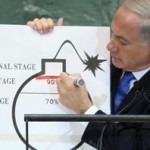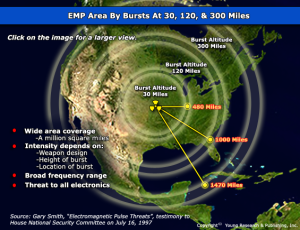Amb. Henry F. Cooper, Chairman Lt. Gen. Daniel Graham, Founder
High Frontier . . Building Truly Effective Defenses . . Reagan’s Vision Lives!
E-Mail Message 130325
As this week ends with the 30th anniversary of Ronald Reagan’s March 23, 1983 speech that launched his Strategic Defense Initiative (SDI), which many believe was a major factor in ending the Cold War:
- The U.S. Senate finally passed its first budget in four years, and left town for Easter break;
- President Obama returned from a whirlwind trip to Israel and Secretary of State Kerry headed back to the Middle East to discuss “peace”— no doubt including concerns about the growing threat from Iran;
- Congressional leaders and others criticized Defense Secretary Hagel’s missile defense announcement last week that included again changing plans on a ground-based site in Poland;
- Acting Under Secretary of State for Arms Control, Rose Gottemoeller, was in Moscow—no doubt exploring President Obama’s promise to Russia’s President Putin of more “flexibility” after his re-election and setting the stage for a future visit by the President’s National Security Advisor, Tom Donilon, to discuss further reductions in our strategic forces, even while
- The U.S. Senate is reneging on its commitment to repair the nation’s atrophying infrastructure needed to sustain our nuclear deterrent, made in exchange for its agreement with President Obama to ratify the New Start Treaty; and
- Growing congressional concern that the administration is ignoring the Iranian threat while
increasing its response to the North Korean threat, which it had previously
also underestimated.
Meanwhile, there is little to nothing positive to report on any effort by the Washington powers that be to deal with the existential threat posed by electromagnetic pulse (EMP) effects—from either manmade or natural (solar) causes. But there are some hopeful signs from the “grass roots,” which we at High Frontier plan to encourage.
The Strategic Forces Big Picture.
Before commenting on EMP issues, consider the points in a March 20 letter to President Obama from Congressman Mike Rogers (R-AL), Chairman of the Strategic Forces Subcommittee of the House Armed Forces Committee (HASC). He noted:
- “Deep concern” about the President’s “sudden shift” in missile defense strategy, especially as “another concession on U.S. missile defenses”— as in 2009, cutting plans to deploy a missile site in Poland to defend the U.S. and our allies in the region from Iranian missiles.
- His inability to understand why this “concession” was made three weeks before the President’s budget submission (allegedly on April 9) “as a prelude” to his National Security Advisor’s Moscow visit, reportedly ”to gauge Russian willingness to pursue further nuclear reductions.” [Ed. Beyond the ill-advised levels of New Start Treaty ratified during the past congress’ Lame Duck session].
- The concession canceled his plan to deploy the Navy’s Standard Missile-3 (SM-3) Block IIB interceptor In an Aegis Ashore site in Poland—a program which he instituted in 2009 after canceling previously agreed plans to deploy there the same Ground Based Interceptors as are in Alaska and California. [Ed. This again sends our European allies into a tizzy trying to figure out what if anything they can rely upon among the promises of the current administration.]
- These obvious concessions to Russian demands no doubt reflected the President’s interest in future nuclear reductions, presumably consistent as yet unannounced plans for our strategic forces and his commitment to seek a world with no nuclear weapons, perhaps to be made public in the upcoming anniversary of the April 5, 2009 Prague speech, which presented President Obama’s vision of a world without nuclear weapons. [Ed. Idealism run amok.]
Rep. Rogers closed by wisely urging the President and his administration instead to use their time and political capital to resolve the current arms control compliance concerns; to ensure that Iran does not obtain a nuclear weapon capability; and to bolster our defensive and offensive military cooperation with South Korea and Japan in the context of North Korea’s heralded threat. To emphasize the validity of Chairman Rogers’ concern, consider the following sample of last week’s headlines from around the world:
- U.S. CANCELS LAST PHASE OF MISSILE DEFENSE SYSTEM THAT RUSSIA OPPOSED, The New York Times, March 17, 2013.
- SHELVING OF 4TH PHASE OF ABM IN EUROPE BY US NO SURPRISE FOR RUSSIA – AIDE, ITAR-TASS, March 19, 2013.
- OBAMA’S FLEXIBILITY NOT ENOUGH TO PLEASE PUTIN, The Moscow Times, March 19, 2013.
- US CANCELS PART OF MISSILE DEFENSE SYSTEM, Voice of America, March 21, 2013.
- RUSSIA WELCOMES US READINESS FOR MISSILE DEFENSE DIALOGUE, Russia Times, March 21, 2013
- RUSSIAN DIPLOMAT WELCOMES US EFFORTS ON ABM DIALOGUE, THREAT REDUCTION PROGRAM, BBC Monitoring Former Soviet Union, March 21, 2013
- CZECH SITE SEES CANCELLED US ANTI-MISSILE SHIELD PLANS AS CONCESSION TO RUSSIA, BBC Monitoring Europe, March 21, 2013
- RUSSIA TONES DOWN CRITICISM OF NEW US MISSILE PLANS, China Daily European Edition, March 22, 2013.
 All this blather no doubt has been flatly rejected by Russian President Vadimir Putin, as reported by the March 19 Moscow Times article, “Obama’s Flexibility Not Enough to Please Putin” . . . demonstrating once again this administration’s ineptitude in seeking to achieve agreements by preemptively making concessions. The cartoon at left accompanied the Moscow Times’ article which concluded with the author challenging the reader to mark his words, “In the coming days, weeks and possibly months, we will hear Kremlin-friendly analysts with stern facial expressions warn that Obama’s refusal to implement the fourth phase of the European missile defense program is just a clever, cynical trick intended to mask its true intention: to secure and maintain a strategic advantage over Russia.”
All this blather no doubt has been flatly rejected by Russian President Vadimir Putin, as reported by the March 19 Moscow Times article, “Obama’s Flexibility Not Enough to Please Putin” . . . demonstrating once again this administration’s ineptitude in seeking to achieve agreements by preemptively making concessions. The cartoon at left accompanied the Moscow Times’ article which concluded with the author challenging the reader to mark his words, “In the coming days, weeks and possibly months, we will hear Kremlin-friendly analysts with stern facial expressions warn that Obama’s refusal to implement the fourth phase of the European missile defense program is just a clever, cynical trick intended to mask its true intention: to secure and maintain a strategic advantage over Russia.”
Furthermore, as emphasized in a letter to Defense Secretary Hagel from the Chairman, Vice Chairman and several members of the HASC, the administration’s initiatives responded to North Korea’s recent tests of nuclear weapons and ballistic missiles and its explicit threat to preemptively attack the United States. This step was needed because the Obama administration underestimated the North Korean threat in 2009, when it scuttled the Bush administration’s plans for the same number of ground-based interceptors.
How does the administration know that meeting the Iranian threat does not also require more and better missile defenses than currently planned? Especially when taking account of Iranian activities such as recently pointed out by Reza Kahlili, based on his study of Google Earth photography of Iran’s underground facilities and his contacts in the Iranian Revolutionary Guard? What about Reza’s suggestion that Iran Iran has already crossed the “red line” that has so concerned Israeli Prime Minister Netanyahu?
To counter these concerns, we should improve as soon as possible our ballistic missile defenses against the growing Iranian threat. As we have argued previously, these improvements should include deploying Aegis Ashore sites around the Gulf of Mexico to counter the possible launch of missiles from the south by Iran or their surrogate terrorists, including from vessels in the Gulf. High altitude bursts could produce EMP effects that could, within a year, lead to the death of hundreds of millions of Americans.
Observations: On March 19, Chairman Rogers and Senator Kelly Ayotte (R-NH), member of the Senate Armed Services Committee (SASC) elaborated their concerns at a Heritage Foundation/Marshall Institute celebration of the 30th anniversary of Ronald Reagan’s SDI speech. Their comments were during the second hour of a 3-hour session—the first hour of which included comments by High Frontier’s Chairman, Ambassador Hank Cooper.
The administration is playing a cynical game with our strategic defenses—on the one hand, it is pointing to the recent North Korean threats to preemptively attack the United States and bill-boarding its restoration of plans to deploy in Alaska the 14 Ground-Based Interceptors (GBIs) that it cut from the missile defense program it inherited from George W. Bush in January 2009; on the other hand, it is, for at least the second time, dramatically changing its plans and programs to deploy missile defenses in central Europe to protect the U.S. and our allies against the growing Iranian threat.
This stop-start programmatic activity costs considerably more than maintaining a stable program, of course—frittering away both time and valuable resources. And the specific plans seem to give a lower priority to the Iranian threat—even though it is well known that North Korea and Iran (and China and Russia) have worked together on both nuclear weapons and the ballistic missiles to deploy them.
These activities that undercut our strategic defenses are coupled to an arms control agenda that threatens to unilaterally disarm America of its nuclear strategic forces. This continues the approach the administration took in negotiating the lopsided New Start Treaty, incredibly approved by a number of alleged defense minded Republicans and all Democrats, during the last Congress’ Lame Duck session.
As should have been expected by all those senators “who went along with New Start,” Congress and the Obama administration are not living up to commitments made “in exchange for ratification votes”—promises to assure the viability of our nuclear weapon stockpile and its associated production and maintenance complex infrastructure, as well as our atrophying strategic delivery systems.
The administration no doubt recognizes that this fact will make it very difficult to get another New Start Treaty through the current Senate . . . “Fool me once, shame on you . . .”
So, the big worry now is the administration’s agreement on some set of executive agreements derived from its propensity for appeasement in pursuing its foreign policy and arms control goals.
Stay tuned!
The Foggy EMP Picture Continues.
While the existential threat of either a natural or manmade EMP event has been understood for almost a decade, the Washington bureaucracy continues to dither in pursuing any serious set of countermeasures. As reviewed in our February 25th email report, there is considerable confusion about who is responsible for dealing with this threat—though a number of departments and agencies have related capabilities and responsibilities. As the saying goes, “When everyone’s responsible, no one’s responsible.”
To recap and briefly summarize:
- The Department of Defense (DoD) has capabilities and know-how but is doing little if anything to protect our critical infrastructure to assure the survival of the American people—not their job.
- The Department of Homeland Security (DHS) has at least some responsibility for defining existential threats to the U.S. homeland, but doesn’t even include an EMP scenario among the dozen or so provided to guide all the agencies of the U.S. government, as well as state and local authorities to provide for the security of the American people. (Note: DoD does Homeland Defense; DHS does Homeland Security—whatever that distinction means.)
- The Department of Energy (DOE) has equity, smarts and procedural knowhow, but is not engaged in a constructive way in taking steps to protect the nation—even though the main source of U.S. energy, our Electric Power Grid upon which our very national survival depends, is our most vulnerable infrastructure to a major EMP event.
- DOE and DHS sponsored an important October 2010, Oak Ridge National Laboratory study―Electromagnetic Pulse: Effects on the U.S. Power Grid, which included a series of comprehensive technical reports for the Federal Energy Regulatory Commission (FERC). These reports disclosed that the commercial power grids in two large areas of the continental United States are vulnerable to “severe space weather”—read solar activity that can result in a large earth-directed solar storm or Coronal Mass Ejection (CME), inducing a major Geomagnetic Disturbance (GMD) capable of causing long-term outages (months to years) of the commercial electric power grids in these vulnerable areas.
- The Federal Energy Regulatory Commission (FERC) is an independent regulatory agency within DOE, but apparently neither the administration nor Congress reviews FERC decisions; but the federal courts can review FERC decisions. FERC apparently pays for itself by recovering costs directly from the industries it regulates through annual charges and fees. Its regulations to deal with EMP, if any, have no teeth since the electric power industry ignores this threat.
- Under current law, the responsibility for developing electric power grid standards rests with the North American Electric Reliability Corporation (NERC), an electric industry consortium. NERC’s reliability
 standards are the planning and operating rules that electric utilities follow, including to ensure system reliability under stress. NERC produced a 2012 report largely downplaying the seriousness of the “natural” solar threat—a view roundly refuted by several authoritative scientific reports, including from the EMP Commission, the National Academy of Sciences, and several DOE National Laboratories in studies for the FERC. Whatever the NERC standards may be, they were not developed by an advertised “balanced, open, fair and inclusive process.”
standards are the planning and operating rules that electric utilities follow, including to ensure system reliability under stress. NERC produced a 2012 report largely downplaying the seriousness of the “natural” solar threat—a view roundly refuted by several authoritative scientific reports, including from the EMP Commission, the National Academy of Sciences, and several DOE National Laboratories in studies for the FERC. Whatever the NERC standards may be, they were not developed by an advertised “balanced, open, fair and inclusive process.” - Among the NERC’s many current committees is the Geomagnetic Disturbance Task Force (GMDTF), supposedly in a process to update its initial defective assessment of the solar threat, but observers to the GMDTF are not impressed that this report will be much improved over the 2012 one. (Apparently NERC has not yet considered the EMP threat from a high altitude nuclear burst—asserting that is a DoD responsibility.)
- Perhaps the most responsible organization with a dog in this hunt is the Nuclear Regulatory Commission (NRC) which has sole responsibility for the nation’s nuclear power reactors that contribute about 20-percent of the nation’s electric power as discussed in our March 4, 2013 report. If the NRC would lead, perhaps others will follow.
Observations: Congress could be helpful in sorting out these concerns and assuring that the American people are protected from the EMP threat, whether natural or manmade. So far it has failed dismally in two full terms. In the 111th Congress, a bill, referred to as the GRID Act, passed the House by a voice vote and was blocked in the Senate by a single Republican senator. In the 112th Congress, its successor bill, referred to as the SHIELD Act, was blocked in the Energy and Commerce Committee by its Republican Chairman. The leader of the EMP Caucus, Rep. Trent Franks (R-AZ), intends to try again in the current Congress, maybe 113 is the magic number for a revived SHIELD Act . . . Stay tuned.
 Finally, it seems clear that grass roots efforts will be needed to impress on the Washington “powers that be” that the folks back home want to be defended against the threats discussed above.
Finally, it seems clear that grass roots efforts will be needed to impress on the Washington “powers that be” that the folks back home want to be defended against the threats discussed above.
We will report back on our efforts to inform folks around the Gulf of Mexico of the threat from the south against which we are totally defenseless—and what can be done about it. This includes deploying Aegis Ashore sites at military bases around the Gulf—like those we are deploying in Europe to defend them against Iranian missiles.
We will also discuss, at a minimum, the need to harden the electric power grid to assure we can survive a massive solar storm—missile defenses are useless against this natural threat. While there will be other damaging effects from a natural major EMP event, those damages are more easily repaired than would be the transformers that are essential to a viable electric power grid.
On the other hand, if we harden the grid against all the effects of a high altitude nuclear burst, we will have assured the power grid will also survive a massive solar storm.
Grassroots Progress:
An example of the kind of grass roots movement required is being provided in Maine, where a bold Maine Representative, Andrea Boland of Sanford, has introduced legislation to require all new transmission lines being installed under the $1.4 billion Maine Power Reliability Program to have protection against solar storm GMD effects. Her Bill, LD 131, is the first of its type and, if successful, may well set a trend for the future. Representative Boland’s effort is to be commended—this initiative and others like it at the state and local levels can serve to break the bureaucratic impasse in Washington.
And what should you do?
Join us at High Frontier in seeking to alert the public to the existential threats posed by both manmade and natural EMP events—and what can be done about these threats.
We can use your help in spreading the word to grass roots and local authorities to press the powers that be to provide for the common defense as they are sworn to do. Will you do your part?
Begin by passing this message to your friends and suggest they visit our webpage, www.highfrontier.org for more information. Also, please encourage your sphere of influence to sign up for our weekly e-newsletter! 
Please follow us on Facebook, Twitter, and Youtube!
Help support the work of High Frontier!
To Review Our Previous Weekly Updates, Please Click Here!







